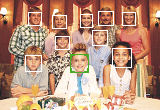The next generation of digital cameras is coming out, following announcements timed to the PMA (Photo Marketing Association) conference held last month in Las Vegas.
 The good news for consumers is the end of the artificial megapixel wars. Instead, the new trends are really helpful developments in the image processing chips that assist with shooting better photos -- including stabilizing camera shake and enhancing focus and exposure with amazing technology like face recognition.
The good news for consumers is the end of the artificial megapixel wars. Instead, the new trends are really helpful developments in the image processing chips that assist with shooting better photos -- including stabilizing camera shake and enhancing focus and exposure with amazing technology like face recognition.
Megapixels are no longer a big issue -- most cameras have more than enough resolution for Web photos and even normal-size prints, and 4 to 5 MPs should be enough for even full-page prints. And note that "high-definition" video at 1920 x 1080 resolution is only 1.7 MP, so these cameras also can shoot up to HD video clips -- some even can capture video and photos simultaneously.
We're also seeing a movement away from tiny pocketable cameras to devices with better lenses, readable displays, and manageable controls -- after all, these days we're already carrying a camera in our mobile phone -- now often with multiple megapixels.
Instead, consumer cameras are getting more powerful, easier to use, and adding some really interesting features that can help you take better pictures. As you look at the new models, you'll see trends like larger LCD displays -- some touch screen, and some with auto-brightness adjustment for better visibility in difficult lighting. And you'll notice clever approaches to folding better lenses into handheld devices, some with up to 10X zoom, -- including Kodak's Dual Lens cameras with switchable lenses and the Canon PowerShot TX1 with the lens mounted out the side like a video camera.
But there's even more interesting improvements inside the cameras, in the image processing chips that are now being promoted with brand names. Optical image stabilization (not digital) adjusts the lens to compensate for unwanted camera motion, not only reducing blurred photos, but also allowing shooting with longer zoom and lower light levels.
Exposure improvements include features to boost ISO levels with more aggressive noise reduction, variable flash levels to add some fill light without washing out the scene, and multi-shot modes to bracket the scene with higher and lower exposure levels or by shooting with and without flash. Some cameras also have motion detection features to boost ISO and shutter speed if the subject is in motion, or to wait for movement to stop before shooting in self timer mode.
Perhaps the most amazing new technology appearing in digital cameras is face recognition. The typical problem when shooting a group portrait is to have the camera focus on the background behind the group, and under-expose the scene because of a bright background. New cameras with face recognition actually look for multiple faces in a scene, and then set focus and exposure to optimize for the people that are the purpose of the photo. Some cameras then let you review the photo in the viewfinder by stepping through zoomed-in views of each face -- up to as many as 10 faces in each shot.
The next big feature coming to digital cameras is GPS to associate location with your photos, so that you can organize and search your collection geographically in tools like Adobe Photoshop Elements.
For more on trends and sample digital cameras, see the Digital Photo Cameras Gallery.
